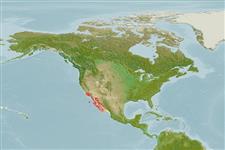Environment: milieu / climate zone / rango de profundidad / distribution range
Ecología
marino demersal; rango de profundidad 5 - 79 m (Ref. 9330). Subtropical; 37°N - 22°N
Eastern Pacific: Monterey Bay in California, USA to Gulf of California.
Tamaño / Peso / Age
Madurez: Lm ? range ? - ? cm
Max length : 63.5 cm TL macho / no sexado; (Ref. 40637); common length : 25.0 cm TL macho / no sexado; (Ref. 9330); peso máximo publicado: 4.0 kg (Ref. 40637)
Short description
Claves de identificación | Morfología | Morfometría
Inhabits muddy and sandy bottoms, from 4.6-79 m depth. Usually buried in bottoms. Feeds almost exclusively on crustaceans. Marketed fresh (Ref. 9330).
Life cycle and mating behavior
Madurez | Reproducción | Puesta | Huevos | Fecundidad | Larva
Oviparous (Ref. 101737). Distinct pairing (Ref. 205). Females produce numerous eggs in multiple spawnings during a prolonged spawning period (Ref. 101737).
Eschmeyer, W.N., E.S. Herald and H. Hammann, 1983. A field guide to Pacific coast fishes of North America. Boston (MA, USA): Houghton Mifflin Company. xii+336 p. (Ref. 2850)
IUCN Red List Status (Ref. 130435: Version 2025-1)
Threat to humans
Harmless
Human uses
Pesquerías: escaso valor comercial; pesca deportiva: si
Herramientas
Special reports
Download XML
Fuentes de Internet
Estimates based on models
Preferred temperature (Referencia
123201): 18.2 - 23.3, mean 22.2 °C (based on 24 cells).
Phylogenetic diversity index (Referencia
82804): PD
50 = 0.7500 [Uniqueness, from 0.5 = low to 2.0 = high].
Bayesian length-weight: a=0.00776 (0.00436 - 0.01383), b=3.17 (3.02 - 3.32), in cm total length, based on LWR estimates for this species & (Sub)family-body (Ref.
93245).
Nivel trófico (Referencia
69278): 3.5 ±0.50 se; based on food items.
Resiliencia (Referencia
120179): Medio, población duplicada en un tiempo mínimo de 1.4-4.4 años (Preliminary K or Fecundity.).
Fishing Vulnerability (Ref.
59153): Moderate to high vulnerability (45 of 100).
🛈
